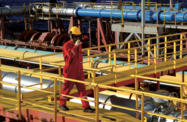Increased crude production in Saudi Arabia, combined with rising oil prices, has put the Kingdom on track to generate record annual revenues for the sector, with recent figures from Riyadh-based Jadwa Investments indicating that income could reach a yearly high of $288bn for 2012.
Brent crude is expected to average $111.80 per barrel for 2012, according to US Energy Information Administration (EIA) forecasts, and the average price per barrel for WTI (West Texas Intermediate) should be around $95.50.
Saudi Arabia is expected to maintain strong levels of overall economic growth in the short term, buoyed by these high oil revenues, which account for 86% of annual revenue. With crude production standing at between 9.7m and 10m barrels per day since November 2011, according to OPEC, GDP growth rates for 2012 have been forecast to reach between 5% and 6%. The IMF estimates that GDP per capita could rise by up to 10% this year.
However, concerns remain that rapid economic growth and the rising population are likely to push up the Kingdom’s already high consumption rate, leading to a possible further hike in domestic subsidy levels, which could impact future budget plans.
Saudi Aramco, the Kingdom’s national oil and gas company, has invested heavily in upstream and downstream projects. In late September, Aramco’s CEO, Khalid Al Falih, gave details of the Kingdom’s plans to strengthen its oil business as it looks to meet rising demand, saying, “We plan to invest $35bn over the next five years in crude oil exploration and development alone to keep our oil production portfolio robust”.
Heavy Arabian crude production from its offshore Manifa field is expected to reach approximately 500,000 bpd by the second quarter of 2013 and 900,000 bpd by 2014, which would offset capacity losses from other ageing fields.
Domestic gas production has also been earmarked for a significant role in Saudi Arabia’s energy policy as the country moves to keep pace with rising electricity consumption. Comments from Aramco officials and the Kingdom’s minister of petroleum and mineral resources carried by local press in recent months have focused on two projects: the Karan offshore gas field and the Wasit Gas project.
The Karan offshore gas field, which began producing non-associated gas in the summer of 2011, should reach a capacity of 1.8bn cu ft a day by 2013, increasing overall output by 18%. The Wasit Gas Project, which is expected to be up and running by mid-2014, will provide an additional capacity of 2.5bn cu ft a day, contributing 21% of overall output. Once operational, the two projects will increase total output by 39%.
Aramco also announced in late October that it had selected the contractors to carry out engineering, procurement and construction work on the multi-billion-dollar Jazan Refinery and Terminal project.
With a potential capacity of 400,000 barrels per day, the refinery forms a key component of the oil company’s plans to expand downstream activities. The project, which is scheduled for completion in 2016, will refine Arabian Heavy and Arabian Medium crude oils, and produce gasoline, ultra-low sulfur diesel, benzene and paraxylene.
The selected contractors include Petrofac Saudi Arabia (Saudi Arabia), Hyundai Arabia (Saudi Arabia), Hanwha Engineering and Construction Corporation (Korea), SK Engineering & Construction Company (Korea), Tecnicas Reunidas (Spain), JGC Corporation (Japan), and Hitachi Plant Technologies (Japan).
Although near-term production continues to rise in Saudi Arabia and large-scale project financing is taking shape, analysts have also highlighted the pressure of increasing domestic consumption that the country’s rapid economic growth has produced, particularly its high demand for energy at home. Saudi Arabia has the highest per capita energy consumption rate in the world, consuming upwards of 2.8m bpd, which is more than a quarter of its own energy output, the Economist reported in March.
In a recent analysis, Citigroup said, “We would expect consumption to continue to outstrip population growth as Saudi Arabia’s currently young population ages and consumer spending increases supported by rising GDP per capita.”
Local power providers pay for fuel at price levels between $5 and $15 per barrel, according to Citigroup, while market prices are more than $100 per barrel. “As a result of its subsidies we calculate ‘lost’ oil and gas revenues to Saudi Arabia in 2011 to be over $80bn,” the company’s analysis concluded.
For now, the Kingdom’s economic growth remains robust. Overall, oil prices are expected to remain high, while new gas output is set to enhance overall capacity almost 40% by 2014. Substantial investment in both upstream and downstream projects should steer the Kingdom toward even higher crude oil production levels and refining capacity by mid-decade.

